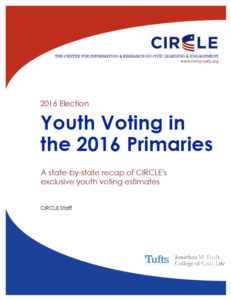Youth Voting in the 2016 Primaries
 Throughout the 2016 primaries, CIRCLE conducted state-by-state analyses of youth voting in both parties’ nominating contests. As this month’s Republican and Democratic conventions officially bring the primary season to a close, this fact sheet revisits the day-after youth turnout estimates we calculated for each state contest and expands on the major trend we have highlighted throughout: a considerable increase in young people’s electoral participation compared to 2008, the last year both parties had competitive primaries.
Throughout the 2016 primaries, CIRCLE conducted state-by-state analyses of youth voting in both parties’ nominating contests. As this month’s Republican and Democratic conventions officially bring the primary season to a close, this fact sheet revisits the day-after youth turnout estimates we calculated for each state contest and expands on the major trend we have highlighted throughout: a considerable increase in young people’s electoral participation compared to 2008, the last year both parties had competitive primaries.
Read: Youth Voting in the 2016 Primaries
Our main takeaways include:
– Youth Participation Increased in 2016: In 17 of the 24 states for which we have both 2008 and 2016 estimates, the percentage of young people (ages 17-29) eligible voters who cast a ballot in 2016 was equal to or greater than in 2008.
– GOP Youth Drove the Increase: In every single one of the 21 states for which we can make the comparison, as many or more youth votes were cast in the 2016 Republican primaries or caucuses than in the 2008 contests. In contrast, on the Democratic side, a majority of states for which we have data experienced a drop in youth voting.
– However, More Young People Overall Voted in Democratic Primaries: In 18 of the 26 states for which we could produce 2016 estimates, the number of youth votes cast in Democratic contests exceeded those for the GOP. In six states, young Democratic voters outnumbered young Republicans at the ballot box by more than 2-to-1.
As we consider the potential for young people to continue having an impact this November, in both the presidential and in congressional races, these data are a useful guide to where young voters have been participating in this election cycle—and need continued outreach so that they remain engaged through November—and where even more effort is needed to reach and encourage young people to participate in the democratic process.





